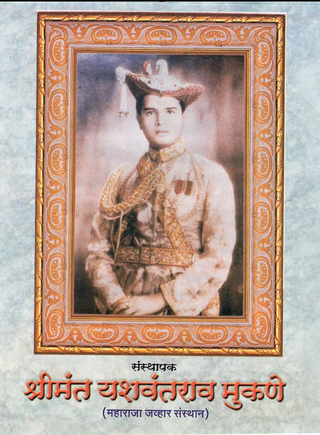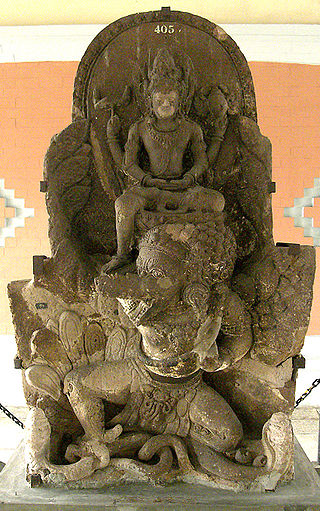
Mahārāja is a Sanskrit title for a "great ruler", "great king", or "high king".

Srivijaya, also spelled Sri Vijaya, was a Buddhist thalassocratic empire based on the island of Sumatra that influenced much of Southeast Asia. Srivijaya was an important centre for the expansion of Buddhism from the 7th to the 11th century AD. Srivijaya was the first polity to dominate much of western Maritime Southeast Asia. Due to its location, Srivijaya developed complex technology utilizing maritime resources. In addition, its economy became progressively reliant on the booming trade in the region, thus transforming it into a prestige goods-based economy.

Singhasari, also known as Tumapel, was a Javanese Hindu-Buddhist kingdom located in east Java between 1222 and 1292. The kingdom succeeded the Kingdom of Kediri as the dominant kingdom in eastern Java. The kingdom's name is cognate to the Singosari district of Malang Regency, located several kilometres north of Malang City.

The Shailendra dynasty was the name of a notable Indianised dynasty that emerged in 8th-century Java, whose reign signified a cultural renaissance in the region. The Shailendras were active promoters of Mahayana Buddhism and covered the Kedu Plain of Central Java with Buddhist monuments, one of which is the colossal stupa of Borobudur, now a UNESCO World Heritage Site.

The Mataram Kingdom ; also known as Medang Kingdom was a Javanese Hindu–Buddhist kingdom that flourished between the 8th and 11th centuries. It was based in Central Java, and later in East Java. Established by King Sanjaya, the kingdom was ruled by the Shailendra dynasty and Ishana dynasty.

Chi Tu was an ancient kingdom mentioned in the history of China. The Sui dynasty annals describe an advanced kingdom called Chi Tu in 607, when Chang Chun was sent as an ambassador there. The location of Chi Tu was disputed; proposals for its location include areas in the states of Kelantan or Pahang in Malaysia, or in Songkhla and Pattani Province of southern Thailand. The best evidence to support the Kelantan theory was when the envoys left Chi Tu, the sail took 10 days to reach Champa, this indicates the kingdom was located somewhere 'red earth' around the main river of Kelantan. The inscribed Buddhagupta Stone found in Kedah mentioned a Raktamrttika, meaning "red earth land".
Dharmawangsa, stylized regnal name Sri Maharaja Isyana Dharmawangsa Teguh Anantawikramottunggadewa of the Isyana dynasty, was the last raja of the Kingdom of Mataram, who reigned from 990 to 1016 CE. He is also known by his posthumous name Wijayamreta Wardhana, which means "powerful in glorious death", which refers to his fight to the death.

Raden Wijaya or Raden Vijaya was a Javanese emperor, and the founder and first monarch of the Majapahit Empire. The history of his founding of Majapahit was written in several records, including Pararaton and Negarakertagama. His rule was marked by the victory against the army and the Mongol navy of Kublai Khan's Yuan dynasty.

Airlangga, regnal name Rakai Halu Sri Lokeswara Dharmawangsa Airlangga Anantawikramottunggadewa, was the only king of the Kingdom of Kahuripan.

Sri Maharajadiraja Sri Kertanegara Wikrama Dharmatunggadewa, Kritanagara, or Sivabuddha, was the last and most important ruler of the Singhasari kingdom of Java, reigning from 1268 to 1292. Under his rule Javanese trade and power developed considerably, reaching the far corners of the Indonesian archipelago.

Tribhuwana Wijayatunggadewi, known in her regnal name Tribhuwannottunggadewi Jayawishnuwardhani, also known as Dyah Gitarja or Gitarja, was a Javanese queen regnant and the third Majapahit monarch, reigning from 1328 to 1350. She also bears the title Bhre Kahuripan. With the help of her prime minister Gajah Mada, she pursued a massive expansion of the empire. Tradition mentioned her as a woman of extraordinary valour, wisdom and intelligence.
Jayanegara or Jayanagara was a Javanese emperor and the second monarch of the Majapahit Empire from 1309 to his death in 1328, and also Prince of Kediri from 1295. Jayanegara was the heir, crown prince, and only son of Raden Wijaya, the founder of Majapahit. The story of his life was written in several records, including the Pararaton and Negarakertagama. His reign saw the beginning of Gajah Mada's rise to influence in the empire.
The Blambangan Kingdom was the last Javanese Hindu kingdom that flourished between the 13th and 18th centuries, based in the eastern corner of Java. The capital was at Banyuwangi. It had a long history of its own, developing contemporaneously with the largest Hindu kingdom in Java, Majapahit (1293–1527). At the time of the collapse of Majapahit in the late fifteenth century, Blambangan stood on its own as the one solitary Hindu state left in Java, controlling the larger part of Java’s Oosthoek.

Kahuripan was an 11th-century Javanese Hindu-Buddhist kingdom with its capital located around the estuarine of Brantas River valley in East Java. The kingdom was short-lived, only spanning the period between 1019 and 1045, and Airlangga was the only raja of the kingdom, which was built out of the rubble of the Kingdom of Mataram after the Srivijaya invasion. Airlangga later in 1045 abdicated in favour of his two sons and divided the kingdom into Janggala and Panjalu (Kadiri). The kingdom's name derived from Old Javanese term hurip with circumfix ka- -an which means "life" or "livelihood". Later in 14th to 15th century, the former kingdom was recognised as one of Majapahit's 12 provinces.

Ni Ketut Mahadewi Istarani is an Indonesian badminton player specializing in doubles, from PB. Jaya Raya Suryanaga Surabaya she later affiliated with Djarum club. She was the women's doubles bronze medalist at the 2015 SEA Games with her partner Anggia Shitta Awanda. She announced her retirement from the international badminton tournament on 11 June 2022.
Sri Cudamani Warmadewa or Sri Cudamani Varmadeva or written as Shi-li-zhu-luo-wu-ni-fo-ma-tiao-hua, was an emperor of Srivijaya which belongs to the Sailendra dynasty, who reigned in Kedah in the late 10th century CE. He was known as an able and astute ruler, a clever tactician with shrewd diplomatic skills. His reign was quite renowned since during his period, the kingdom faced a dire crisis; the naval invasion of Javanese Mataram Kingdom. He was the nemesis of King Dharmawangsa of Java.
Samara Vijayatunggavarman was the Maharaja of Srivijaya from 1045 CE.
Sang Ratu Sri Janasadhu Warmadewa was a king of the Warmadewa dynasty, who ruled Bali around the end of the 10th century CE. Based on various inscriptions, he was the fifth king of the dynasty. King Janasadhu's name has been found in only one inscription, namely the Sembiran inscription, which was dated to 897 Saka.











